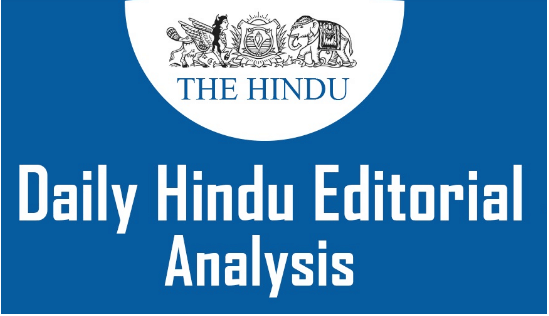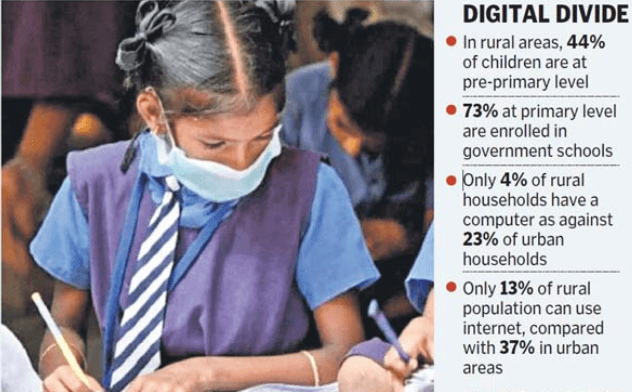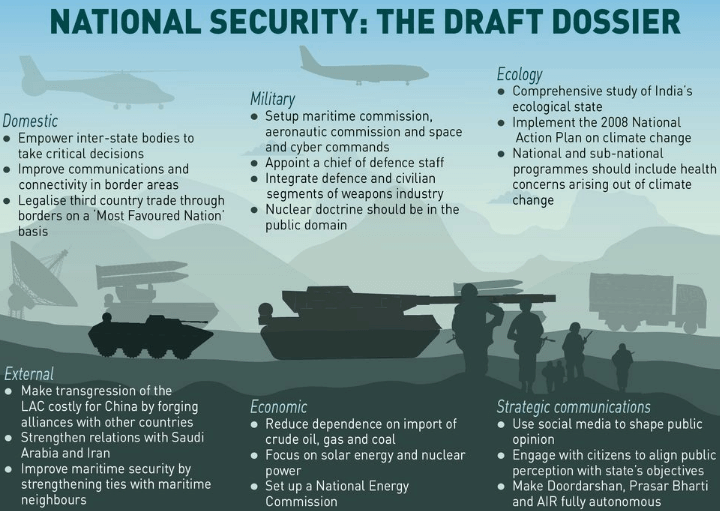The Hindu Editorial Analysis- 10th Sept, 2020 | Additional Study Material for UPSC PDF Download

1. DIGITAL DISCONNECT: ON ONLINE LEARNING AND DIGITAL DIVIDE-
GS 2- e-governance- applications, models, successes, limitations, and potential
Context
The full report of the NSO’s survey of ‘Household Social Consumption on Education in India’, for July 2017-June 2018, highlights the poor state of computer and Internet access in several States.

Net Access
(i) The disparities(division) are glaring(striking) among different economic strata as well.
(ii) The digital chasm(divide) that separates the privileged from the deprived remains unbridged years after the broadband policy of 2004, and its effects are painfully evident during the pandemic as students struggle to log on to online classes.
(iii) While some poorly connected States may have improved since the survey period, the gaps are so stark that any development could only be modest.
(iv) Only in Delhi, Himachal Pradesh and Kerala did the survey find Internet access exceeding 50% for urban and rural households taken together, while Punjab, Haryana and Uttarakhand exceeded 40%, unimpressive numbers still.
(v) Large States — Uttar Pradesh, Tamil Nadu, Andhra Pradesh and Karnataka — had access below 20%.
(vi) In today’s milieu, net access is critical, considering that even where mobile phones and laptops are available — some States provide them under student welfare programmes — they cannot be meaningfully used in its absence.
(vii) If net connectivity is 5% to 10% in rural Odisha, Madhya Pradesh, Telangana, Karnataka and West Bengal, only a slim minority can hope to do any academic work.
(viii) Many remote locations have reliability problems and power deficits, making it a challenge to keep gadgets operational even offline.
Raising Administrative Qualities
(i) Prime Minister has acknowledged the digital divide by announcing in his Independence Day address that all villages would be connected with optical fibre cable in 1,000 days.
(ii) This target, reflecting enhanced ambition, follows the one set in 2011 to link panchayats through a national optical fibre network — to raise administrative capacities through information infrastructure.
(iii) Evidently, successive governments have dropped the ball. States have not shown the alacrity(liveliness) to make a big leap either, and the deficit has now dealt a blow to students.
(iv) To make up for lost time, connectivity for education must be prioritised.
(v) Mapping the needs of each district based on the NSO data will help identify areas where children do need equipment and connectivity.
(vi) Such efforts have been launched globally in the wake of COVID-19, some in partnership with the telecom sector to leverage its capacity for surveys and mapping.
(vii) Some companies in India have made the valuable suggestion that their used desktop computers could be refurbished(re-made) and donated, for which governments need to open a programme.
(viii) On the network technology front, a new gigabit speed ‘wireless fibre’ standard is being viewed in developed countries as a leapfrog option to link inaccessible areas.
(ix) Wireless fibre involves high capacity spectrum (E and V bands), and is commercially not contentious(disputed).
(x) The government needs to look at all possibilities and go into overdrive to bridge the digital divide.
Conclusion
Poor access to the Internet in many States must be bridged urgently to help e-learners.
2. A NECESSARY PAUSE: ON THE COVID-19 VACCINE RACE-
GS 2- Issues relating to development and management of Social Sector/Services relating to Health
Context
The global clamour(call) for a COVID-19 vaccine has whipped up(excite) unrealistic expectations that one is just around the corner(near).


On Hold
(i) It is thus a reality check when biopharma company Astra Zeneca, piloting its vaccine candidate, AZD1222 — there were large Phase-3 trials this month — said it was voluntarily putting the multi-national trial on hold.
(ii) This was after a ‘serious adverse(harmful) event’ in a volunteer, which a data safety monitoring board will now examine.
(iii) The company’s move was first reported by an independent medical news site, underlining the critical role that independent scrutiny plays in one of the greatest global crises.
(iv) Without a specific cure, the vaccine quest has become more than just a search along the pathway that research and pharma companies have traditionally taken.
(v) There are demands that probable vaccines be put into a pipeline(plan) for accelerated approval to yield political dividends(benefits) too.
Transparent Evaluation
(i) U.S. President Trump has ‘demanded’ that a vaccine be available before voting day in November.
(ii) India had its moment of vaccine controversy when the ICMR harried trialists to expedite testing of Bharat Biotech’s Covaxin by August 15.
(iii) Russia, which is to commence its Sputnik V’s Phase-3 testing, has launched a publicity blitz.
(iv) Just before reports of the trial pause, AstraZeneca and eight companies developing vaccines signed a pledge that they would not approach regulatory authorities, such as the U.S. FDA, until they had safety and efficacy data from a Phase-3 trial.
(v) Overall, the road to a vaccine has become an arena for marketing and jingoism(excessive nationalism).
(vi) AZD1222 has already been tested in Phase-1 and Phase-2 trials, where the data on its safety and ability to induce a relevant response by the immune system were evaluated and independent peer-review had deemed it fit to be tested in larger populations.
(vii) A Phase-3 trial is the most daunting(challenging) one.
(viii) In the case of a vaccine, there is the additional burden of proof that it can not sicken the healthy and the odds of adverse reactions greatly increase when a piece of virus is injected into thousands of volunteers.
(ix) Vaccine trials take years of development precisely because of the chances of unexpected complications and to expect a vaccine, which has cleared accelerated Phase-1/2 trials, to inexorably(unpreventable) clear Phase-3, flies in the face of(contradicts) evidence from the history of vaccine development.
(x) Developed at Oxford, AZD1222 was evolved on an adenovirus platform not used in a commercially approved vaccine in humans.
(xi) They have however been used in an experimental Ebola vaccine.
(xii) India and the world will gain from a vaccine that has been critically and transparently evaluated and not one that crosses a chimerical(illusionary) finish line first.
Conclusion
Vaccines take time to develop; the first to roll out might not necessarily be the best.
3. RETHINKING THE DEFENCE DOCTRINE-
GS 2- Important aspects of governance, transparency and accountability
Context
(i) Over four months ago, the Chinese army entered territory that India has long considered its own, and never left.
(ii) In effect, the multiple incursions have changed the Line of Actual Control (LAC) and India has lost territory, at least for the time being.
(iii) How could this happen?
(iv) In part, it was a failure of the warning-intelligence system.
(v) Either Indian intelligence services did not collect sufficient data of Chinese intentions and early moves, or they did not interpret(understand) it correctly.
(vi) Or their policy and military customers failed to take the warning seriously.
(vii) Wherever the fault lay, the system apparently failed.

Punitive Offensives
(i) In part, however, the problem also lay in the Army’s concepts for defending the country’s borders.
(ii) It is, as the current crisis shows, simply not postured or prepared for the type of security threat China presents.
(iii) As I argued in a recent research study for Carnegie India, the Army’s prevailing(existing) doctrine is designed to deter(prevent) and defend against major conventional invasions.
(iv) This determines how the Army is organised, what equipment it operates, and where it is deployed.
(v) The Army expects to win wars, against Pakistan or China, by launching its own punitive offensives after an enemy attack, to either destroy enemy forces or seize(capture) enemy land.
(vi) In this mindset, the Army expected that any Chinese bid to capture Indian territory would come as a major conventional invasion, as it did in 1962.
(vii) The Indian response would accordingly involve large formations, with planning and command decisions made at the Corps headquarters or higher.
Security Threat
(i) But the Chinese army’s initial forays(attacks) in April and May did not look like a guns-blazing invasion.
(ii) It crossed the LAC in several places nearly simultaneously, and in larger numbers than usual.
(iii) Still, the Indian Army probably expected the stand-off would repeat the pattern of years past: China would make its point with a temporary transgression and retreat after talks.
(iv) In the meantime, Indian forces would reinforce their positions but hold back.
(v) Indian forces were under strict instructions from New Delhi that any aggressive response must be avoided as it would inflame the situation.
(vi) It is now clear that the national security leadership and the Army miscalculated.
(vii) China has no interest in launching a major conventional invasion, but this is not just a typical probe either.
(viii) Rather, its quick land grab looks increasingly permanent, like an attempt to change the border without triggering war.
(ix) This fait accompli leaves India with two awful choices: either start a war by launching its own reprisal attack, or do nothing and accept a new status quo.
(x) Addressing this type of security threat requires preventing, not reversing, such fait accompli(done deal) land grabs.
(xi) This requires a fundamental shift in the Army’s doctrinal thinking, from strategies revolving around punishing the adversary(enemy), to strategies that prevent its adventurism in the first place.
Speed Is Of The Essence
(i) In practice, this does not mean an unbroken picket of soldiers all along the border.
(ii) It does, however, mean a greater investment in persistent wide-area surveillance to detect and track adversary(enemical) moves, devolved command authority to respond to enemy aggression, and rehearsed procedures for an immediate local response without higher commanders’ approval.
(iii) In countering China’s ‘grey zone’ tactics of quick land grabs, speed is of the essence.
(iv) The military must be able to detect adversary action and react quickly, even pre-emptively, to stop attempted aggression from becoming a fait accompli.
(v) In peacetime, local commanders must have the authority and gumption to take anticipatory action and go on the offensive or fill forward defensive positions.
(vi) The late-August incident at Chushul demonstrates how this can and should work.
(vii) Indian special forces troops took position on previously unoccupied heights south of Pangong Tso.
(viii) In so doing they have complicated future Chinese moves to consolidate their position, and may even hold some Chinese positions at risk. The country’s attempts to seize(capture) more ground have been foiled(failed).
(ix) Unfortunately, China was not foiled in its initial seizure of Indian territory.
(x) Reversing that occupation will require a remarkable feat of Indian statecraft.
Conclusion
(i) A military solution is decreasingly likely as China reinforces its deployments.
(ii) Taking strident offensive actions now, amidst a heavily militarised crisis, may be hazardous because it carries new risks of unintended escalation.
(iii) The challenge for India is to learn the right lessons and be alert to similar tactics in other regions, like the Indian Ocean.
(iv) It must not rely on doctrines(beliefs) forged(built) in wars half a century ago.
|
21 videos|562 docs|160 tests
|
FAQs on The Hindu Editorial Analysis- 10th Sept, 2020 - Additional Study Material for UPSC
| 1. What is the analysis of The Hindu editorial on 10th Sept, 2020? |  |
| 2. What is the importance of The Hindu editorial analysis for UPSC exam preparation? |  |
| 3. How can The Hindu editorial analysis be useful in answering UPSC exam questions? |  |
| 4. How can one access The Hindu editorial analysis? |  |
| 5. How often should one read The Hindu editorial analysis for UPSC exam preparation? |  |





















